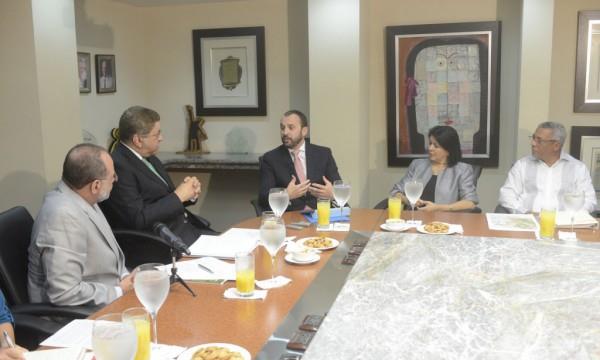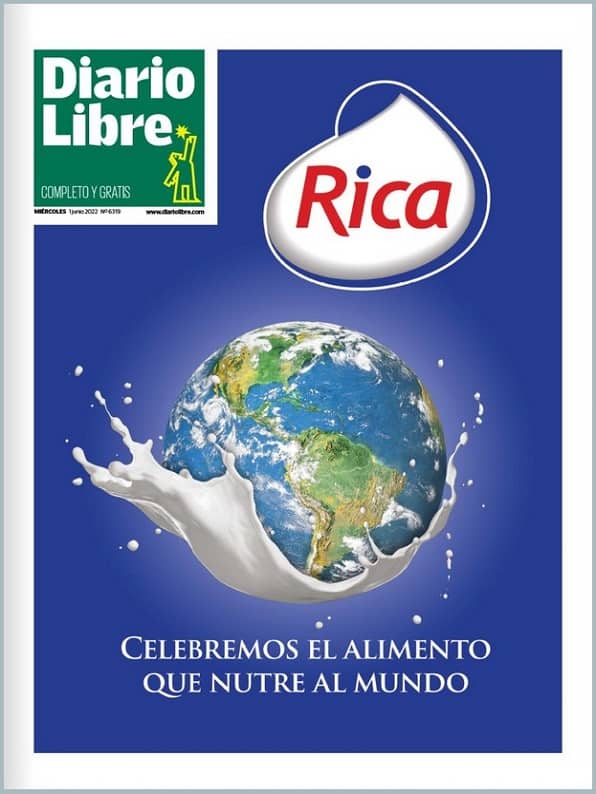"Loma Miranda has no important species"
Falcondo executives insist there is only one river

SANTO DOMINGO. Executives of Falconbridge Dominicana insist that among the biodiversity characteristics of Loma Miranda there does not exist any species of importance, nor are there waters which are suggested by some ecological groups, and that, therefore, there is no reason to say that it should be protected.
David Soares, the president and general manager of the company and Fernando Cabrera, the environmental leader of Falcondo, support their affirmations on the environmental impact studies that they have, which-they insist-are world class and backed by two international firms that are among the four best in their area.
"When they do studies on what there is there (Loma Miranda), they are going to find that there in neither flora nor fauna of importance," suggested Cabrera.
He said that in this part of the Central Mountains there exists a large degree of manmade influence which, while it creates great biodiversity, it does not necessarily mean that it is of importance.
"An outstanding Dominican ecologist spoke of the great diversity that there is there. Well, in the garden in my house there is great biodiversity. Wherever that is manmade influence, there is a lot of diversity," the Falcondo environmentalist commented. He insisted that there are no endemic species in Loma Miranda. Regarding the fauna, he mentioned that there were some rats that have no impact.
"Which is to say that there is absolutely nothing, no kind of species of fauna or flora that is in danger," he said.
Regarding the waters, he used the topographic studies from the University Cartography Institute to demonstrate that the only superficial moving water that comes from Miranda is that of the Jaguey River and this river does not flow into the Rincon dam, which serves irrigation and drinking water needs for the province. He also showed a hydrological report carried out by the National Institute of Hydraulic Resources (INDRHI), in 1989, which concluded that the aquifers are practically inexistent.
Study to be expanded
Regarding the report which last year the United Nations Development Program (UNPD) presented, which concluded that the environmental impact study by the company was superficial and insufficient, the Falconbridge executives, with their reservations, admitted that they should expand some aspects.
"We planned to carry out additional or complementary studies to the first study that we did. We are planning this now," Soares pointed out.
Cabrera expanded by saying that they foresee the inclusion of ecosystem studies that are not in the original because when it was delivered to the Ministry of the Environment in March 2010, it was not common practice to include such studies.
Another aspect to be considered, pointed out by the UNDP, was the issue of migratory birds which was "weak" in the original study. Also mentioned was the hydrological balance, but as Soares explained, not because they think that they will have any impact of the rivers, but rather because of the handling of the waters at the mine.
In order to carry out these studies the company requires the authorization of the Environmental Ministry, since by order of a tribunal in La Vega, moved by the opposition of community and religious groups, they are kept from carrying out any activity in Miranda.
"We want those permits in order to carry out these additional studies that I believe that the country is waiting for....We are now working to create the terms of reference, And we are also asking for the approval in order to begin these new studies," commented Soares.
They guarantee that the mine will have little impact and there will be remediation
A constant complaint of the groups opposed to the mining exploitation of Loma Miranda is that this mountain will become a hole, but the Falcondo executives assured reporters that this was not the case.
They say that they will only mine the surface, and that this will be corrected with an effective plan that they have designed. Besides leaving 53% of the area as a protected area, and concentrating on mining 7,000 tareas (about 600 hectares), they will make terraces where the topsoil will be placed (which was scrapped away), and plant grass to avoid erosion. Later they will plant fast growing trees and later on, native species. "It will vary with the rainfall and the micro-climate of these areas, but between 15 and 25 years later the area will return a close as possible to what it was originally," said Fernando Cabrera. He defended the criteria used to lay out the roads, but he did not discard the impact of erosion and sedimentation, above all during the rainy season.
Report by UNDP questioned
Ever since the report which was carried out by the UNDP was released at the request of the Dominican government regarding the advisability or not of converting Miranda into a mine, the Falcondo executives expressed their rejection of the adverse conclusions.
David Soares, Fernando Cabrera and Arelis Rodriguez, the director of the Falcondo Foundation, reiterated their opposition to the report mentioned above during their participation in the Dialogo Libre of the Diario Libre newspaper which was hosted by the paper's director, Adriano Miguel Tejada.
Cabrera pointed out that the UNDP indicated things that have no value, and that they did not do the study but rather revise one that was already done.
Soares, for his part, criticized the influence used by the persons that the technicians of the agency interviewed who he said could have been prejudiced.
Arelis Rodriguez complained that they did not interview key persons, community groups with which they had worked from the beginning.
"I thought that if you were going to carry out an evaluation as to how we worked with the communities, you would interview them. There was none of this. We even went so far as to tell them if we could set it up, (since) many of the associations sent us letters asking for the visits and they never happened. Then, in part of the study, they say that nobody spoke in favor of us. It is very hard to talk if nobody asks questions," Rodriguez pointed out.
Soares also questioned that "the UNDO" reaches some conclusions, but at the beginning they say that the UNDP is not responsible."
Loma Miranda was a sawmill for Trujillo
The environmental leader for Falcondo, Fernando Cabrera, said that on Loma Miranda there are barely 110 tareas (about six hectares) that could be considered to be virgin, and he warned that this hill has not always had the importance it has today, when ecological, community and religious groups are trying to get it declared a protected area. Cabrera recalled that in the 1940s, the area was handed over by the dictator Rafael Leonidas Trujillo to Doctor Jose R. Soba, who installed a sawmill in the place.
"Since the 40s what was in Loma Miranda was a sawmill, and because of this there was the community of La Manaquita, where the sawmill workers lived." Dr. Soba was one of the trusted doctors of Trujillo and even became the Secretary of Public Health.
Many times, when they talk about this, they refer to Loma Miranda as if it were all of the Central Mountains. This is a little hill that is on a spur of the Central Mountains, and this hill, not even when it was virgin forest had the importance that they have given it," insisted Cabrera.
David Soares, the president and general manager of the company and Fernando Cabrera, the environmental leader of Falcondo, support their affirmations on the environmental impact studies that they have, which-they insist-are world class and backed by two international firms that are among the four best in their area.
"When they do studies on what there is there (Loma Miranda), they are going to find that there in neither flora nor fauna of importance," suggested Cabrera.
He said that in this part of the Central Mountains there exists a large degree of manmade influence which, while it creates great biodiversity, it does not necessarily mean that it is of importance.
"An outstanding Dominican ecologist spoke of the great diversity that there is there. Well, in the garden in my house there is great biodiversity. Wherever that is manmade influence, there is a lot of diversity," the Falcondo environmentalist commented. He insisted that there are no endemic species in Loma Miranda. Regarding the fauna, he mentioned that there were some rats that have no impact.
"Which is to say that there is absolutely nothing, no kind of species of fauna or flora that is in danger," he said.
Regarding the waters, he used the topographic studies from the University Cartography Institute to demonstrate that the only superficial moving water that comes from Miranda is that of the Jaguey River and this river does not flow into the Rincon dam, which serves irrigation and drinking water needs for the province. He also showed a hydrological report carried out by the National Institute of Hydraulic Resources (INDRHI), in 1989, which concluded that the aquifers are practically inexistent.
Study to be expanded
Regarding the report which last year the United Nations Development Program (UNPD) presented, which concluded that the environmental impact study by the company was superficial and insufficient, the Falconbridge executives, with their reservations, admitted that they should expand some aspects.
"We planned to carry out additional or complementary studies to the first study that we did. We are planning this now," Soares pointed out.
Cabrera expanded by saying that they foresee the inclusion of ecosystem studies that are not in the original because when it was delivered to the Ministry of the Environment in March 2010, it was not common practice to include such studies.
Another aspect to be considered, pointed out by the UNDP, was the issue of migratory birds which was "weak" in the original study. Also mentioned was the hydrological balance, but as Soares explained, not because they think that they will have any impact of the rivers, but rather because of the handling of the waters at the mine.
In order to carry out these studies the company requires the authorization of the Environmental Ministry, since by order of a tribunal in La Vega, moved by the opposition of community and religious groups, they are kept from carrying out any activity in Miranda.
"We want those permits in order to carry out these additional studies that I believe that the country is waiting for....We are now working to create the terms of reference, And we are also asking for the approval in order to begin these new studies," commented Soares.
They guarantee that the mine will have little impact and there will be remediation
A constant complaint of the groups opposed to the mining exploitation of Loma Miranda is that this mountain will become a hole, but the Falcondo executives assured reporters that this was not the case.
They say that they will only mine the surface, and that this will be corrected with an effective plan that they have designed. Besides leaving 53% of the area as a protected area, and concentrating on mining 7,000 tareas (about 600 hectares), they will make terraces where the topsoil will be placed (which was scrapped away), and plant grass to avoid erosion. Later they will plant fast growing trees and later on, native species. "It will vary with the rainfall and the micro-climate of these areas, but between 15 and 25 years later the area will return a close as possible to what it was originally," said Fernando Cabrera. He defended the criteria used to lay out the roads, but he did not discard the impact of erosion and sedimentation, above all during the rainy season.
Report by UNDP questioned
Ever since the report which was carried out by the UNDP was released at the request of the Dominican government regarding the advisability or not of converting Miranda into a mine, the Falcondo executives expressed their rejection of the adverse conclusions.
David Soares, Fernando Cabrera and Arelis Rodriguez, the director of the Falcondo Foundation, reiterated their opposition to the report mentioned above during their participation in the Dialogo Libre of the Diario Libre newspaper which was hosted by the paper's director, Adriano Miguel Tejada.
Cabrera pointed out that the UNDP indicated things that have no value, and that they did not do the study but rather revise one that was already done.
Soares, for his part, criticized the influence used by the persons that the technicians of the agency interviewed who he said could have been prejudiced.
Arelis Rodriguez complained that they did not interview key persons, community groups with which they had worked from the beginning.
"I thought that if you were going to carry out an evaluation as to how we worked with the communities, you would interview them. There was none of this. We even went so far as to tell them if we could set it up, (since) many of the associations sent us letters asking for the visits and they never happened. Then, in part of the study, they say that nobody spoke in favor of us. It is very hard to talk if nobody asks questions," Rodriguez pointed out.
Soares also questioned that "the UNDO" reaches some conclusions, but at the beginning they say that the UNDP is not responsible."
Loma Miranda was a sawmill for Trujillo
The environmental leader for Falcondo, Fernando Cabrera, said that on Loma Miranda there are barely 110 tareas (about six hectares) that could be considered to be virgin, and he warned that this hill has not always had the importance it has today, when ecological, community and religious groups are trying to get it declared a protected area. Cabrera recalled that in the 1940s, the area was handed over by the dictator Rafael Leonidas Trujillo to Doctor Jose R. Soba, who installed a sawmill in the place.
"Since the 40s what was in Loma Miranda was a sawmill, and because of this there was the community of La Manaquita, where the sawmill workers lived." Dr. Soba was one of the trusted doctors of Trujillo and even became the Secretary of Public Health.
Many times, when they talk about this, they refer to Loma Miranda as if it were all of the Central Mountains. This is a little hill that is on a spur of the Central Mountains, and this hill, not even when it was virgin forest had the importance that they have given it," insisted Cabrera.


 Diario Libre
Diario Libre
 Diario Libre
Diario Libre